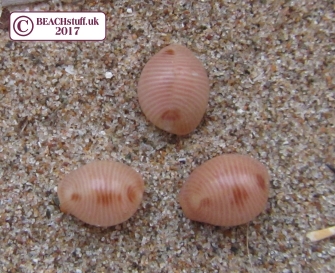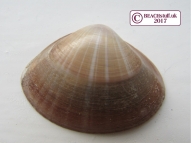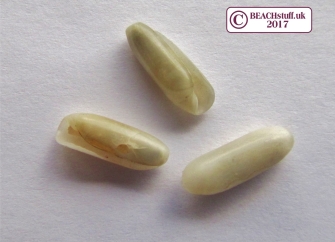

Odd-shaped sea shells
Shells come in all manner of shapes - much more varied than land snails. Here are some of our more uniquely shaped molluscs.
Limpet
The limpet is an extraordinary mollusc - it lives in a conical shell and holds itself fast to the rock with its one large foot. It can live for up to 15 years and always lives in the exact same place. It roams to graze algae from the rocks but always returns to the same little groove it has made itself in the rock.
The limpet is not the same as the slipper limpet, which is described here.

Cowrie
This is my personal favourite shell. I spent my childhood on my hands and knees on the beach collecting these and I am still doing the same now. They are irrestible, largely because they are so unlike any other shell. And partly because the grooves are often so clearly defined making them look very fresh and new.
This little sea snail can sometimes be seen feeding on rocks at very very low tides (see below).
In the photo below, the snail's brown body can be seen partially covering the shell (and can cover more) and it is this which enables the snail to grow the shell from the outside - this is what means the grooves can look so clearly defined regardless of the age of the shell - many other sea snail shells lose their definition and look worn after a life in the sea.
The photograph also shows the snail's, snout, two antenna and a yellow tail.

On our shores we often find two species of cowrie - those without markings (the Northern Cowrie) and those with three spots on their shells (see left) - the European Cowrie. The cowries are not always pink, but can be grey or even black (below).
In Scotland, cowries are known as Groatie Buckies - I defy anyone to find a finer name for a mollusc. Although wentletrap comes close.
Worm snails
These long, curved tubes are the shells of molluscs which are worm-like in shape. The shells may be cemented onto rock and, as such can be mistaken for the homes of marine worms like keel worms. However, while their homes look alike, these are definitely snails rather than worms.
Tusk shells
Sadly, these are not evidence of a herd of tiny elephants on our shores, they are the spent shells of tiny molluscs - often being only one or two centimetres long. They live offshore where they feed on plankton.
Canoe bubble shell
These tiny shells - only around a centimetre are prettry fragile. They are shaped like tiny butter shavings curling over on themselves. The tiny creatures live offshore buried in the sand.
When you see a sea shell and it isn't a sea shell you shell see:
These white shells on stalks house not a sea snail but a barnacle. See our page on barnacles for more information.
These conical white or purple 'towers' are the shells of barnacles.


















